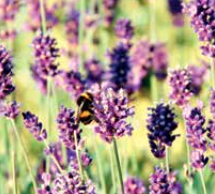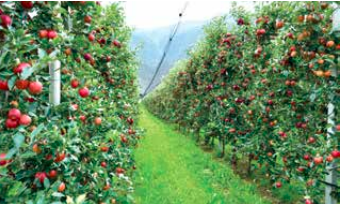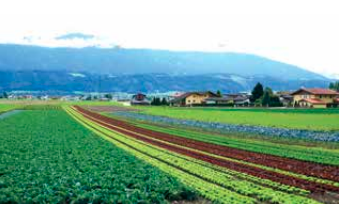Contributed by Ralph Early, Independent Food Scientist and Food Ethicist
Ralph Early discusses the historical and current use of crop protection products in this second of a two-part article
(Page 61 Direct Driller Magazine Issue 6), and focuses on the use of herbicides and insecticides
The first part of this two-part article explored something of the history and use of agricultural pesticides and focused on two important classes: herbicides and insecticides. Attention is given here to other pesticides of importance to farmers, as well as issues of significance associated with their use: principally environmental sustainability and human health.
We have seen that in the production of agricultural food materials herbicides are ubiquitous in the management and control of undesirable plant species that compete with crops and that insecticides are important to both crop and farmed animal protection. Other biotic threats of importance to agricultural food production are various fungal species which can be problematic in crop production, nematodes which threaten plants and animals, and common rodents.
In the production of food materials destined for use in primary processing and food manufacture, farmers seek to gain advantage over the variety of pests that threaten crops and animals. Failure to do so can result in product losses and reductions in yield, quality and profit as well as, in certain instances, food safety hazards. Yet though farmers must seek constantly to control the circumstances in which they produce agricultural foodstuffs through the management of pests, they must also remain cognizant of the possible negative impacts that measures may have on the environment broadly, and specifically local ecology and biodiversity, as well as the capacity to sustain food production resources for future use.
In many respects human survival has always represented a battle with nature, but as the agricultural pesticide industry developed through the 20th century and became an integral part of the mid-century Green Revolution, this notion came to emphasize and underpin modern farmers’ raison d’etre, particularly in Europe and North America. However, with the benefit of hindsight we are now beginning to understand that while synthetic pesticides offer immediate benefits for farmers and consumers they also bring longer-term concerns about negative effects on ecosystems and wild biodiversity. Enlightened farmers, like environmentalists, will therefore find wisdom in the words of Schumacher1 who stated,
“Modern man does not experience himself as a part of nature but as an outside force destined to dominate and conquer it. He even talks of a battle with nature, forgetting that, if he won the battle, he would find himself on the losing side.”

Consequently, as a result of growing concerns, agricultural pesticides are now squarely in the spotlight, from environmental, legal and moral perspectives, and approaches to agricultural food production in which pesticide use is reduced and even eliminated are gaining ground: some of which will be considered here in order to complete this snap-shot of the topic.
Fungicides
Fungi are ubiquitous in most ecosystems and are generally familiar as edible macro-fungi such as meadow mushrooms (Agaricus campestris) which produce large fruiting structures. They represent a kingdom of eukaryotic organisms which includes many species beneficial to human endeavour, for instance bakers’ yeast (Saccharomyces cerevisiae) used in the production of bread and Penicillium roqueforti, the mould used in the production of blue cheeses. Fungi are also represented by the numerous organisms responsible for creating the mycorrhizae essential to the production and maintenance of healthy soils and the growth of many plant species Indeed, fungi are nature’s biodegraders involved in the breakdown and recycling of organic matter including, significantly, the decomposition of lignin, the structural polymer of vascular plants.
The significance of fungi to agricultural crop production lies in their capacity to damage crops, causing reduced yields and crop failure as well as, in some cases, the production of mycotoxins harmful to both humans and animals3. Some fungi of the genus Fusarium are prolific cereal pathogens affecting e.g. wheat and maize. They are capable of producing hepatoxic and nephrotoxic fumonisins, and protein inhibiting trichothecenes.
Various Aspergillus and Penicillium species infect crops such as maize and peanuts producing carcinogenic and nephrotoxic ochratoxins, while organisms from the same genuses can produce the genotoxic mycotoxin, patulin, often associated with apples. The organism Claviceps purpurea infects rye, as well as wheat and barley, and is noted for its mycotoxin, ergot, an alkaloid and the cause of ergotism, consequences of which are convulsions and gangrene. Alongside fungi, and often mistaken as a fungal infection of crops, the organism Phytophthora infestans, an oomycete or water mould, is a disease of tomatoes and potatoes, and was the cause of the late blight that brought the Irish potato famine in 1845-49.
Matthews records the utility of fungicides in temperate and tropical crop production, describing their history and reviewing systemic fungicides. He explains that different fungicides have different modes of action, but all function to interfere with metabolic processes in target organisms, whether as multi-site inhibitors or a single-site inhibitors affecting e.g. the activity of specific enzymes.
Numerous proprietary fungicides are available to farmers and selection can be a minefield, which is why many farmers rely on specialist agronomists for advice. Some fungicides such as products containing fuberidazole (C11H8N2O) are used as seed treatments while others are applied to crops during growth, for instance products containing the active agent difenoconazole (C19H17Cl2N3O3) are used for disease control in fruits, vegetables, cereals and other field crops. Products containing the agents fenamidone (C17H17N3OS) and propamocarb (C9H20H2O2) are used to treat late blight in potatoes, with the former effective against foliar infection while the latter controls soil, root and leaf disease. Fenamidone-based fungicides are also used on e.g. grapes, tomatoes, tobacco and ornamental plants.
Nematicides
Nematodes – commonly termed roundworms – inhabit virtually all ecosystems. The exact number of species is unknown but estimates suggest around 40,000 with authors frequently describing and classifying new ones. Nematodes vary in size. Some are microscopic, typically 0.1 mm in length, with some species a few millimetres long and up to 1m in the case of several parasitic species. Nematodes vary between 5µm and 100µm in diameter. Of the numerous species, Caenorhabditis elegans, a soil organism, is the most extensively described and serves as a model in research.
From the perspective of agricultural food production, nematodes may be categorized as beneficial or harmful, i.e. as pests which require control. Beneficial predatory nematodes can be used as a form of biological control in the protection of crops from attack by cutworms, or caterpillars of the large yellow underwing moth (Noctua pronuba), the heart and dart moth (Agrotis exclamationis) and the turnip moth (Agrotis segetum), all of which can present problems for growers of potatoes and root vegetables, lettuce and cereals..

In Britain the potato cyst nematode (PCN) represents a particular problem for farmers. The twelve species of PCN belong to the genus Globodera and frequent the roots of the Solanaceae family, e.g. potatoes and tomatoes. As natives of the Andes, PCNs are not present in British fields until introduced, following which they can become a nuisance. AHDB5 states that PCNs are the most important potato pests in Britain capable of causing substantial yield losses, with two species, Globodera rostochiensis and Globodera pallida of concern. However, G. pallida is now more widespread due to a prolonged hatching period and selection pressure provided by the cultivation of potato varieties resistant to G. rostochiensis.
Control of nematodes by synthetic pesticides commonly employed the carbamate insecticide, aldicarb (C7H14N2O2S), which functions as a cholinesterase inhibitor. But it is extremely toxic and environmentally persistent, having been implicated in the collapse of ecosystems and the irreversible poisoning of farmland. It is also considered to be carcinogenic to humans. Consequently, biological methods of nematode control in crop production are of particular interest as an alternative to synthetics. Matthews4 describes use of the bacterium, Pasteuria nisizawae, a cyst nematode parasite, as a means of such control. He also reports the use of biopesticides derived from fungi such as Paecilomyces lilacinus, which is one of a number of nematophagous fungi producing toxins able to immobilize nematodes.
A variety of parasitic nematode species affect farmed animals e.g. cattle, sheep and pigs, some of which are a threat to humans, such as the large roundworm, Ascaris suum, which causes ascariasis in pigs. Roundworm treatments include piperazine (C4H10N2), anthelmintics, such as benzimidazoles (C7H6N2) and ivermectin, a preparation derived from avermectins, naturally occurring compounds derived from fermentations produced by the soil actinomycete, Streptomyces avermitilis.
Rodents
Rodents as pests in agriculture are also familiar to those who work in the food industry. One of the key methods of control in agriculture is the pest-proofing of buildings and produce storage facilities in order to prevent structural damage and, importantly, the contamination of products with urine and faeces as well as cross-contamination with spoilage and pathogenic microorganisms. The common mouse (Mus musculus) and brown rat (Rattus norvegicus) are associated with farms and together carry a range of rodent-borne diseases, such as Salmonellosis, Trichinellosis, Leptospirosis and Weil’s disease (a more serious form of leptospirosis).
Anticoagulant, coumarin-based poisons have long been used to poison rodents in domestic and industrial situations, including farms. Warfarin, a first generation anti-coagulant, has commonly been used and disrupts vitamin-K metabolism involved in the synthesis of various proteins including some necessary to blood clotting6. A number of more toxic, second generation anticoagulants are now available, including difenacoum, brodifacoum and flocoumafen, all based on 4-hydroxycoumarin. The use of rodenticides on farms is tightly controlled under the UK Rodenticide Stewardship Regime.
Looking To The Future
As a tactical instrument of control, agricultural pesticides offer benefits to farmers and society in the management of pests in crop and animal production. However, increasing concerns about long-term strategic use and their negative effects on the environment, ecosystem stability and human health are causing environmentalists, public health authorities and policy makers to review rationales for continued use. It is clear that industrial agriculture, of which synthetic pesticides are an integral part, is not sustainable. The need to develop global food systems which are both Ecological by Design and Ethical by Design7 & 8 is now understood by many authorities and the part that pesticides might play in such systems will be rigorously scrutinized. Indeed, for many years approaches to reducing and eliminating pesticides have been explored, principally because of environmental concerns but now also because of concerns about human health.

Organic farming methods are well documented as an approach to food production that limits the use of pesticides, although some traditionally used compounds, such as copper sulphate, are extremely toxic. Agroecology, as detailed by Rosset and Altieri9, may gain ground world-wide as a form of agricultural food production that excludes synthetic pesticides and various governments are exploring its potential. Integrated pest management (IPM) as an approach to pest control in crop production has been under development since the 19th century10. It aims at reducing the use of pesticides through a combination of biological, cultural, mechanical and chemical pest control methods, thereby minimizing negative effects on wild biodiversity. However, concerns are raised that although pesticide use is permitted within IPM the prophylactic use of e.g. neonicotinoids challenges the spirit and practice of the technique11.
Precision agriculture using a range of technologies including satellite imaging and remote sensors feeding data to artificial intelligence (AI) systems controlling drones or UAVs (unmanned aerial vehicles) and robotic tractors are taking agricultural food production in new directions. Bongiovanni and Lowenberg-Deboer12 suggest that precision agriculture can contribute to long-term sustainability by enabling the targeted application of off-farm inputs such as pesticides, thereby reducing use. Interestingly, the rationale for precision agriculture appears to challenge agro-chemical industry assertions that agriculture based on the intensive use of chemical inputs can be sustainable.
This may explain why some corporations are investing in precision farming technologies as they may sense that for moral and environmental reasons the sun is setting on the market for synthetic agricultural pesticides. Precision agriculture then offers a strategic opportunity to maintain control over food systems. Indeed, environmental advocacy groups assert that genetically modified (GM) crops were originally developed with just such intentions: being a strategic means of sustaining the market for pesticides whose patents were expiring and, at the same time, exercising commercial control over food systems.
A quarter of a century ago GM crops were promoted as an ethically sound technology aimed at reducing pesticide use. A utilitarian ethical justification claimed that glyphosate tolerant crops would limit to one the number of pesticides applied to a crop as well as reducing quantities used. Environmental groups opposed GM crops on deontological ethical grounds expressing concerns, for example, about the eventual occurrence of glyphosate resistant weeds. In the event such weeds have become a problem in the USA where GM crops have been extensively grown.
To address the problem new GM crops have been developed which tolerate glyphosate and dicamba (3,6-dichloro2-methoxybenzoic acid), the latter being effective against resistant weeds. However, dicamba is controversial as it drifts onto non-target crops, trees and other plants causing severe environmental and economic damage. Lawsuits associated with dicamba are consequently being filed in the USA and linked to GM crop production, some American food companies are being sued over glyphosate found in food products, with claims made that residues may be harmful to human health.
Conclusion
We may think of food as simply a matter of energy replenishment, nutrition and hedonic pleasure. But it is inescapably also a political issue concerning not least the means by which farmers produce raw materials for transformation into saleable food products. Feeding a growing global population is frequently cited as the key challenge of the 21st century, with the prospect of world population reaching some 10 billion by 2050. This is not however the key challenge. Biodiversity loss and global climate change are rationally the priority issues for our time and both are impacted negatively by the world’s industrial food system which, significantly, is the food system commanded by global corporations to feed mainly urban populations. Indeed, if the problems of biodiversity loss and global climate change are not resolved quickly, the question of feeding an expanded world population remains purely academic.
Agricultural pesticide use is now intrinsic to the industrial food system and in many ways has become synonymous with it, as has the use of synthetic fertilizers. The work of organizations such as the Stockholm Resilience Centre (www. stockholmresilience.org) illustrates the need to reduce significantly synthetic pesticide use globally. In resonance with the Schumacher quote, it is becoming increasingly clear that we must learn to develop ways of farming with nature and not against it. So, in this respect, it is in the interests of pesticide manufacturers to transition from old-school 20th century pest control solutions and explore the development of products that are consistent with sustainable food production and, at the same time, the protection and proliferation of wild biodiversity.
Potential will likely be found in the development of biological pesticides, e.g. based on microorganisms and derivatives, possibly using GM technology, and macroorganisms such as arachnids, insects and nematodes, that allow pest control without being ecologically catastrophic. Indeed, we can be sure that the political dimensions associated with agriculture and food production will demand this as social and political concerns about mankind’s effects on the planet increase and take centre stage in national and international policy making.
This article was originally published as ‘Pesticides in Agriculture’ in Food Science and Technology, the journal of the Institute of Food Science and Technology.
